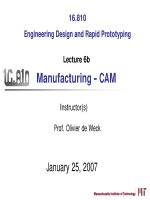Lecture no30 asset depreciation
Bạn đang xem bản rút gọn của tài liệu. Xem và tải ngay bản đầy đủ của tài liệu tại đây (455.25 KB, 16 trang )
Asset Depreciation
Lecture No. 30
Chapter 9
Contemporary Engineering Economics
Copyright © 2016
Contemporary Engineering Economics, 6 th edition
Park
Copyright © 2016 by Pearson Education, Inc.
All Rights Reserved
Chapter Opening Story
Delta Airlines has invested
$100 million in improving
luggage handling
technology and
equipment.
How does the cost of
this baggage handling
system be recognized in
reporting the financial
position of the airlines?
At issue: What is the
cost of owning a piece of
equipment?
Contemporary Engineering Economics, 6 th edition
Park
Copyright © 2016 by Pearson Education, Inc.
All Rights Reserved
Depreciation
• Changes in Market Value
End of
Year
2015
2016
2017
2018
2019
2020
Contemporary Engineering Economics, 6 th edition
Park
Estimated
Market
Value
$25,000
19,000
16,000
14,000
12,000
10,000
Loss of
Value
$6,000
3,000
2,000
2,000
2,000
Copyright © 2016 by Pearson Education, Inc.
All Rights Reserved
Depreciation
Definition: Loss
of value for a fixed
asset
Example: You
purchased a vehicle
worth $25,000 at
the beginning of
year 2016.
Classification of Types of Depreciation
Economic Depreciation
Economic depreciation = Purchase price −
market value
Accounting Depreciation
Based on matching concept; a fraction of
the cost of the asset is chargeable as an
expense in each of the accounting period.
Contemporary Engineering Economics, 6 th edition
Park
Copyright © 2016 by Pearson Education, Inc.
All Rights Reserved
Classification of Depreciation
Contemporary Engineering Economics, 6 th edition
Park
Copyright © 2016 by Pearson Education, Inc.
All Rights Reserved
Why Do We Consider Depreciation?
Business Expense:
Depreciation is
viewed as a part
of business
expenses that
reduce taxable
income.
Contemporary Engineering Economics, 6 th edition
Park
Gross Income -Expenses:
(Cost of goods sold)
(Depreciation)
(operating expenses)
Taxable Income
− Income taxes
Net income (profit)
Copyright © 2016 by Pearson Education, Inc.
All Rights Reserved
Factors to Consider in Asset Depreciation
Depreciable life (how long?)
Salvage value (disposal value)
Cost basis (depreciation basis)
Method of depreciation (how?)
Contemporary Engineering Economics, 6 th edition
Park
Copyright © 2016 by Pearson Education, Inc.
All Rights Reserved
What Can Be Depreciated?
o Assets used in business or held for production of
income.
o Assets having a definite useful life and a life
longer than one year.
o Assets that must wear out, become obsolete or
lose value.
Any qualifying asset for depreciation must satisfy all of the
three conditions above.
Contemporary Engineering Economics, 6 th edition
Park
Copyright © 2016 by Pearson Education, Inc.
All Rights Reserved
Cost Basis
Without Trade-in Allowance
Contemporary Engineering Economics, 6 th edition
Park
With Trade-in Allowance
Copyright © 2016 by Pearson Education, Inc.
All Rights Reserved
Useful Life and Salvage Value
Useful life
Adopt the Asset
Depreciation Ranges
(ADR) published by
the IRS.
Salvage value
Estimated asset value
at the end of its
useful life. If not
possible, a 10% rule
(10% of the initial
value) could be
adopted for
depreciation purpose.
Contemporary Engineering Economics, 6 th edition
Park
Copyright © 2016 by Pearson Education, Inc.
All Rights Reserved
Types of Depreciation
Book Depreciation
Used in reporting net income to
investors/stockholders
Used in pricing decision
Tax Depreciation
Used in calculating income taxes for the IRS
In engineering economics, we use depreciation in
the context of tax depreciation.
Contemporary Engineering Economics, 6 th edition
Park
Copyright © 2016 by Pearson Education, Inc.
All Rights Reserved
Types of Depreciation
Contemporary Engineering Economics, 6 th edition
Park
Copyright © 2016 by Pearson Education, Inc.
All Rights Reserved
Book versus Tax Depreciation: An Overview
Component of
Depreciation
Book Depreciation
Tax depreciation (MACRS)
Based on the actual cost of the
asset, plus all incidental costs
such as freight, site
preparation, installation, etc.
Cost basis
Salvage value
Same as for book depreciation
Estimated at the outset of
Salvage value is zero for all
depreciation analysis. If the
depreciable assets
final book value does not equal
the estimated salvage value,
we may need to make
adjustments in our
depreciation calculations.
Contemporary Engineering Economics, 6 th edition
Park
Copyright © 2016 by Pearson Education, Inc.
All Rights Reserved
Component of
Depreciation
Depreciable
life
Method of
depreciation
Book Depreciation
Firms may select their
own estimated useful
lives or follow
government guidelines
for asset depreciation
ranges (ADRs)
Firms may select from
the following:
o Straight-line
o Accelerated methods
(declining balance,
double declining
balance, and sum-ofyears’ digits)
o Units-of-proportion
Contemporary Engineering Economics, 6 th edition
Park
Tax depreciation (MACRS)
Eight recovery periods—3, 5, 7, 10,
15, 20, 27.5, or 39 years—have been
established; all depreciable assets fall
into one of these eight categories.
Exact depreciation percentages are
mandated by tax legislation but are
based largely on DDB and straightline methods. The SOYD method is
rarely used in the U.S. except for
some cost analysis in engineering
valuation.
Copyright © 2016 by Pearson Education, Inc.
All Rights Reserved
Summary
•
•
•
The entire cost of replacing a machine cannot be
properly charged to any one year’s production;
rather, the cost should be spread (or capitalized)
over the years in which the machine is in service.
The cost charged to operations during a particular
year is called depreciation.
From an engineering economics point of view, our
primary concern is with accounting depreciation,
the systematic allocation of an asset’s value over its
depreciable life.
Contemporary Engineering Economics, 6 th edition
Park
Copyright © 2016 by Pearson Education, Inc.
All Rights Reserved
•
•
Accounting depreciation can be broken into two
categories:
1. Book depreciation—the method of
depreciation used for financial reports and
pricing products
2. Tax depreciation—the method of depreciation
used for calculating taxable income and income
taxes; it is governed by tax legislation
The four components of information required to
calculate depreciation are (a) cost basis, (b) salvage
value, (c) depreciable life, and (d) depreciation
method.
Contemporary Engineering Economics, 6 th edition
Park
Copyright © 2016 by Pearson Education, Inc.
All Rights Reserved









